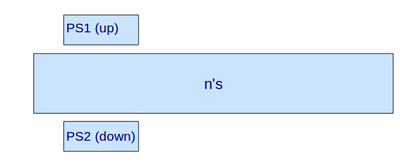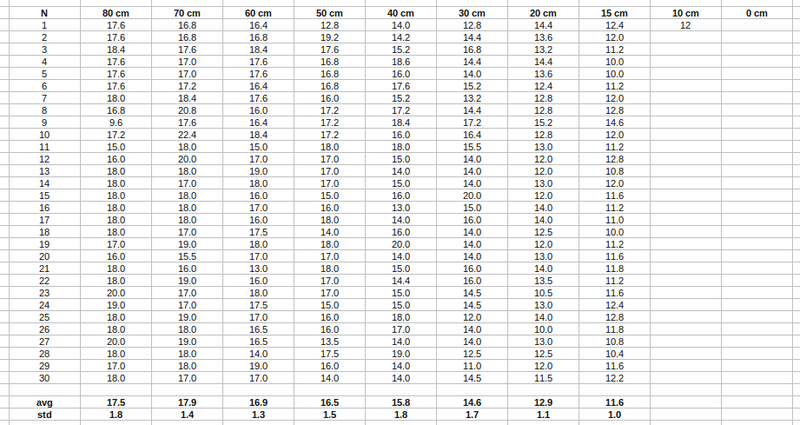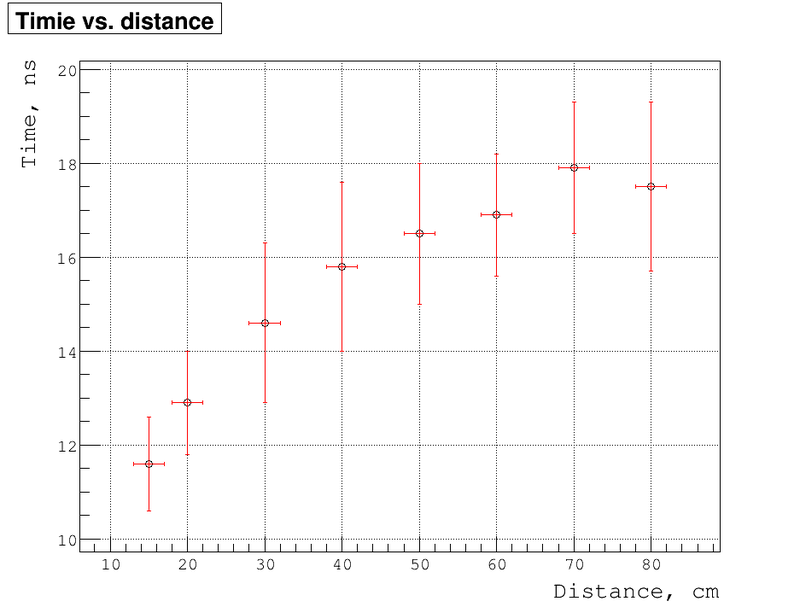Difference between revisions of "05/13/2011 timing test"
Jump to navigation
Jump to search
| Line 28: | Line 28: | ||
'''Let's do the timing test'''. The distances are between PS1+PS2 and n's PMT. The time is time difference between PS1(PS2) and n's detector signals | '''Let's do the timing test'''. The distances are between PS1+PS2 and n's PMT. The time is time difference between PS1(PS2) and n's detector signals | ||
| + | |||
| + | [[File:Tbl timing 03.png | 800px]] | ||
| + | |||
{| border="1" cellspacing="0" style="text-align: center; width: 1000px; height: 100px;" | {| border="1" cellspacing="0" style="text-align: center; width: 1000px; height: 100px;" | ||
! scope="col" width="50" | N | ! scope="col" width="50" | N | ||
| Line 72: | Line 75: | ||
Below is the plot of measured time as function of distances: | Below is the plot of measured time as function of distances: | ||
| − | [[File:Timing | + | [[File:Timing 03.png | 800px]] |
Revision as of 03:47, 17 May 2011
Set up like that:
The voltages, thresholds and widths are:
| PMT voltage, V | threshold, mV | discr. width, ns | |
|---|---|---|---|
| PS1 | -1000 | -80 | 50 |
| PS1 | -1000 | -80 | 50 |
| n's | -1500 | -200 | 10 |
Let's do the timing test. The distances are between PS1+PS2 and n's PMT. The time is time difference between PS1(PS2) and n's detector signals
| N | 80 cm | 70 cm | 60 cm | 50 cm | 40 cm | 30 cm | 20 cm | 15 cm | 10 cm | 0 cm |
|---|---|---|---|---|---|---|---|---|---|---|
| 1 | 17.6 ns | 16.8 ns | 16.4 ns | 12.8 ns | 14.0 ns | 12.8 ns | 14.4 ns | 12.4 ns | 11.2 ns | |
| 2 | 17.6 ns | 16.8 ns | 16.8 ns | 19.2 ns | 14.2 ns | 14.4 ns | 13.6 ns | 12.0 ns | ||
| 3 | 18.4 ns | 17.6 ns | 18.4 ns | 17.6 ns | 15.2 ns | 16.8 ns | 13.2 ns | 11.2 ns | ||
| 4 | 17.6 ns | 17.0 ns | 17.6 ns | 16.8 ns | 18.6 ns | 14.4 ns | 14.4 ns | 10.0 ns | ||
| 5 | 17.6 ns | 17.0 ns | 17.6 ns | 16.8 ns | 16.0 ns | 14.0 ns | 13.6 ns | 10.0 ns | ||
| 6 | 17.6 ns | 17.2 ns | 16.4 ns | 16.8 ns | 17.6 ns | 15.2 ns | 12.4 ns | 11.2 ns | ||
| 7 | 18.0 ns | 18.4 ns | 17.6 ns | 16.0 ns | 15.2 ns | 13.2 ns | 12.8 ns | 12.0 ns | ||
| 8 | 16.8 ns | 20.8 ns | 16.0 ns | 17.2 ns | 17.2 ns | 14.4 ns | 12.8 ns | 12.8 ns | ||
| 9 | 9.6 ns | 17.6 ns | 16.4 ns | 17.2 ns | 18.4 ns | 17.2 ns | 15.2 ns | 14.6 ns | ||
| 10 | 17.2 ns | 22.4 ns | 18.4 ns | 17.2 ns | 16.0 ns | 16.4 ns | 12.8 ns | 12.0 ns | ||
| avg, ns | (16.8 ± 2.6) | (18.2 ± 1.9) | (17.2 ± 0.9) | (16.8 ± 1.6) | (16.2 ± 1.6) | (14.9 ± 1.5) | (13.5 ± 0.9) | (11.8 ± 1.4) |
As the distance becomes 10 cm and less the coincidence rate becomes very low. I have:
- ▫ 11 coincidence for 98 min (10 cm)
- ▫ 0 coincidence for 10 min
Below is the plot of measured time as function of distances:


